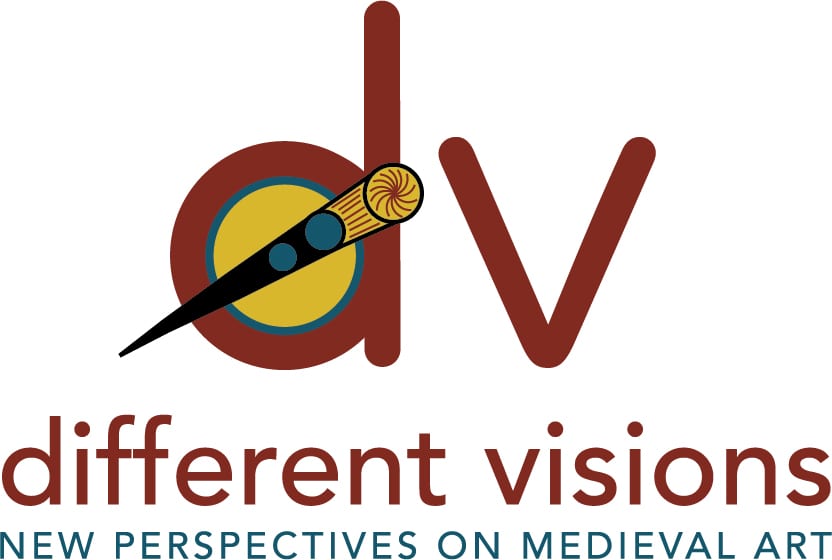The Dinner Party: Invitations Long Overdue
The Material Collective Plays with Food
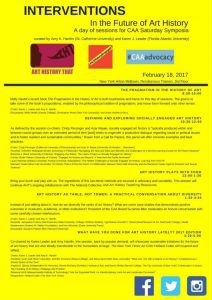 Last summer, the Material Collective was invited by Karen Leader and Amy Hamlin, the founders of Art History That, to participate in their day-long set of sessions at the annual meeting of the College Art Association. The Material Collective and Art History That are fellow travelers in the quest to make art history more relevant, more socially engaged, more playful – and we had collaborated with them before at CAA 2016 in Washington, DC.
Last summer, the Material Collective was invited by Karen Leader and Amy Hamlin, the founders of Art History That, to participate in their day-long set of sessions at the annual meeting of the College Art Association. The Material Collective and Art History That are fellow travelers in the quest to make art history more relevant, more socially engaged, more playful – and we had collaborated with them before at CAA 2016 in Washington, DC.
This time around, we were asked to participate in the lunchtime session, “Art History Plays with Food.” We came up with the idea of rethinking Judy Chicago’s iconic work, The Dinner Party from the 1970s, an installation of 39 place settings representing and honoring mythological and historical women of the past usually excluded from art historical and historical discourse. We thought that we would focus on the plight of contingent faculty in our discipline, and in academia more broadly, in an attempt to invite them to the table and partner with them to search for solutions to the demeaning adjunctification of the professorate.
The Election Changes Everything
After November 8, we changed our minds.
To us, the results of the election have created an even more pressing sense of urgency. The post-election period has spawned a rise of racist, anti-Semitic, Islamophobic, anti-gay, misogynist speech and actions. Not only are some people increasingly excluded from the table, their very identities, even their very lives, are under threat.
To that end, we decided to shift our focus, and invite to the table people representing groups that traditionally have been marginalized, that have been overlooked, that have been actively discriminated against – and in our present political landscape, that are even directly targeted as a result of bigotry and xenophobia. We featured 10 artists who engage with issues of identity, and let them speak for themselves through images of representation, often self-representation.
Ten Artists, Multiple Identities
The artists, eight women and two men, occupy a range of identities. All but one are people of color. Some are Muslim. Some are immigrants. Some are gay or transgender. One is a political refugee. One is autistic. Most of them are working artists at various stages in their careers and at various levels of fame. Two are deceased. One is a contingent faculty member, the group that we had originally wanted to highlight. The artists were, in the order they appeared in our installation (click the links to see the images and biographies):
- Loïs Mailou Jones
- Deborah Kass
- Claude Cahun
- Sausan Saulat
- Bahareh Khoshooee
- Laura Molina
- Mickalene Thomas
- Jaune Quick-to-See Smith
- Jonathan Lerman
- Pipo Ngyuen-Duy
We created place settings with a plate, silverware, glass and napkin; on each plate rested a representative image from each artist. Each place setting was accompanied by a short artist’s biography, either directly supplied by the artist, or drawn from the artist’s website or other vetted sources
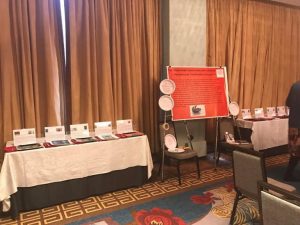
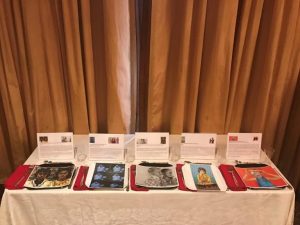
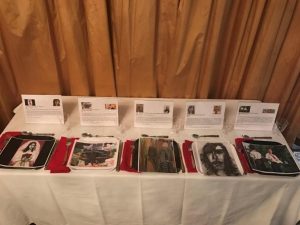
A large poster explaining our project anchored the display, and another poster listed the names of organizations, such as the ACLU, Black Lives Matter, Jewish Voice for Peace, and other advocacy groups.
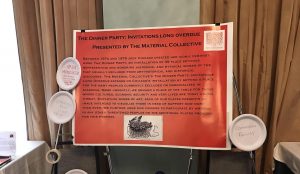
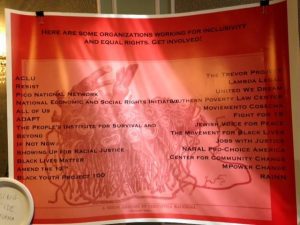
We also had empty paper plates and magic markers available so that people could participate in the project by adding their own names of people or groups marginalized or threatened, or by adding names of organizations.Visitors to our display added these plates: 
- All Indigenous Australians and Islanders
- Standing Rock Sioux Tribe
- Ana Mendieta and the many women who straddle the line
between Latinx and Latin American identities - Contingent Faculty
- Undergrads at CAA 2017
- Rising Tide California
Organizing While White
While we were pleased to be able to present this project, we also did so with not just a modicum of trepidation. The organizers are three white women (Martha Easton, Rachel Dressler, Maggie Williams). The last thing we wanted to do was to speak for others, to appropriate voices not our own or represent others in a way that they would not support. (After all, the original Dinner Party had only one African-American woman, Sojourner Truth, and her plate was the only one of the 39 that did not represent its subject with a vaginal image). We tried to head off any potential conflicts by reaching out, via individual contacts, the Material Collective Facebook page, and CAA more broadly, to scholars who deal more directly with issues of art and race. We received a positive response although no one was available to contribute directly to the project.
We were especially buoyed by the reactions of the artists themselves. We reached out to all of the living artists through various means (and contacted the Jones estate), and the great majority of them responded, very enthusiastically, to our project, often supplying edits to their bios, or high-res images of their work.
The project overall was received in very positive terms. Many people took photos of the individual place settings and the posters, and were supportive of the display and its intentions. We hope that the readers of this blog will enjoy the artists and the work, and appreciate the spirit of the enterprise. We welcome feedback, comments, advice—and most especially, suggestions for further advocacy and activism.
